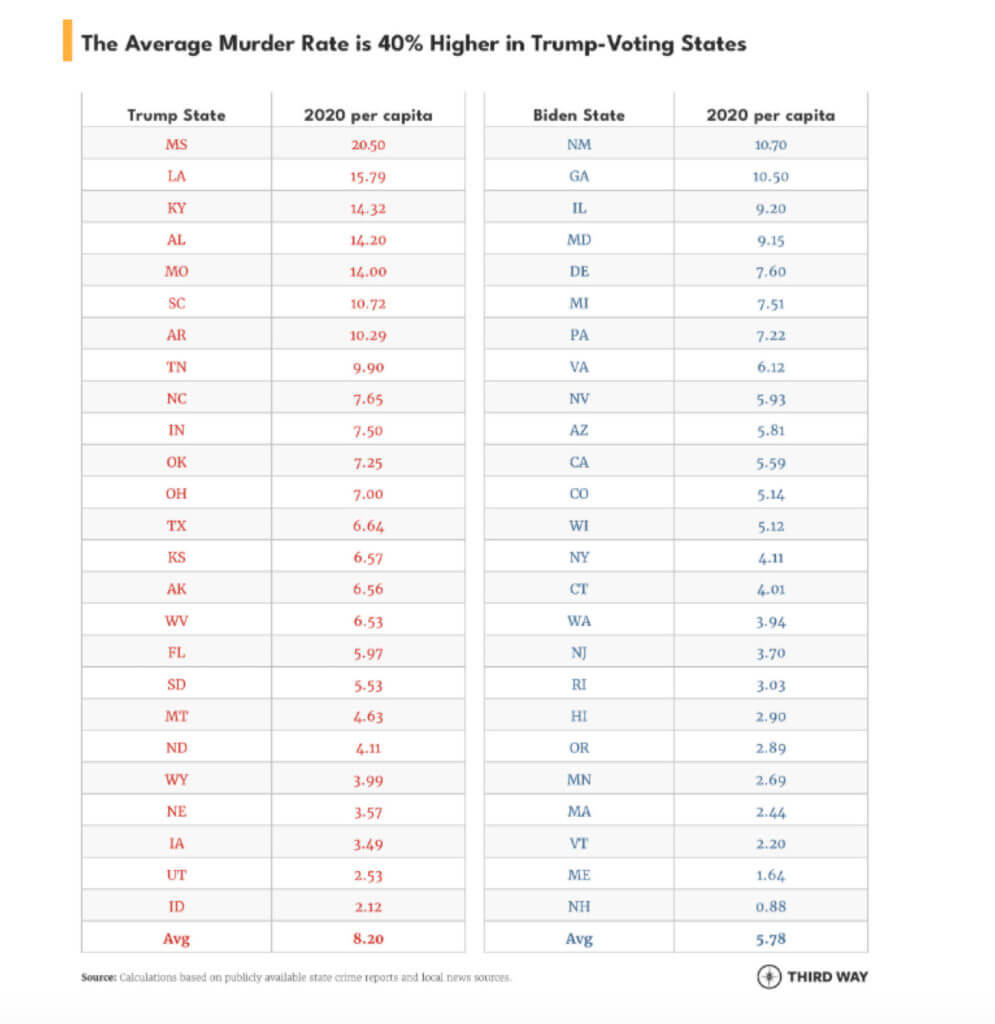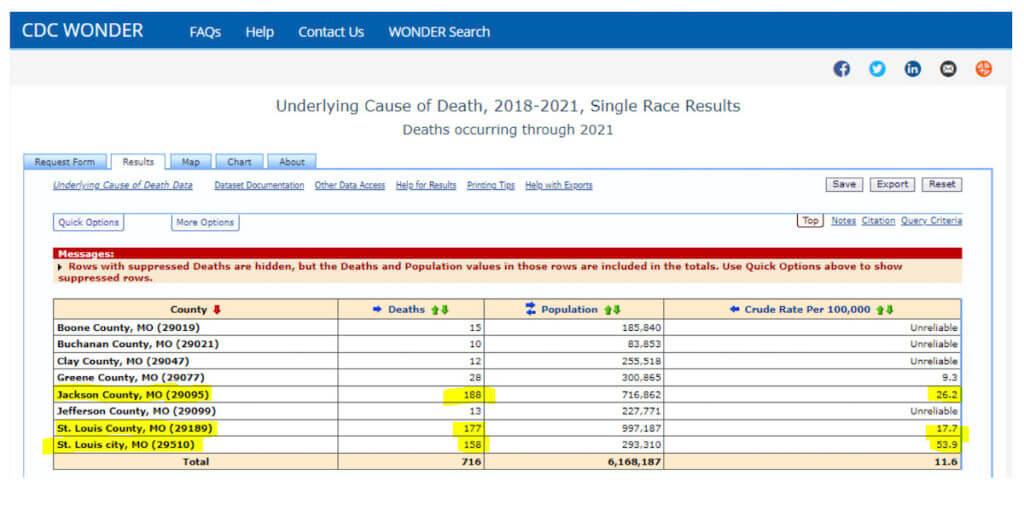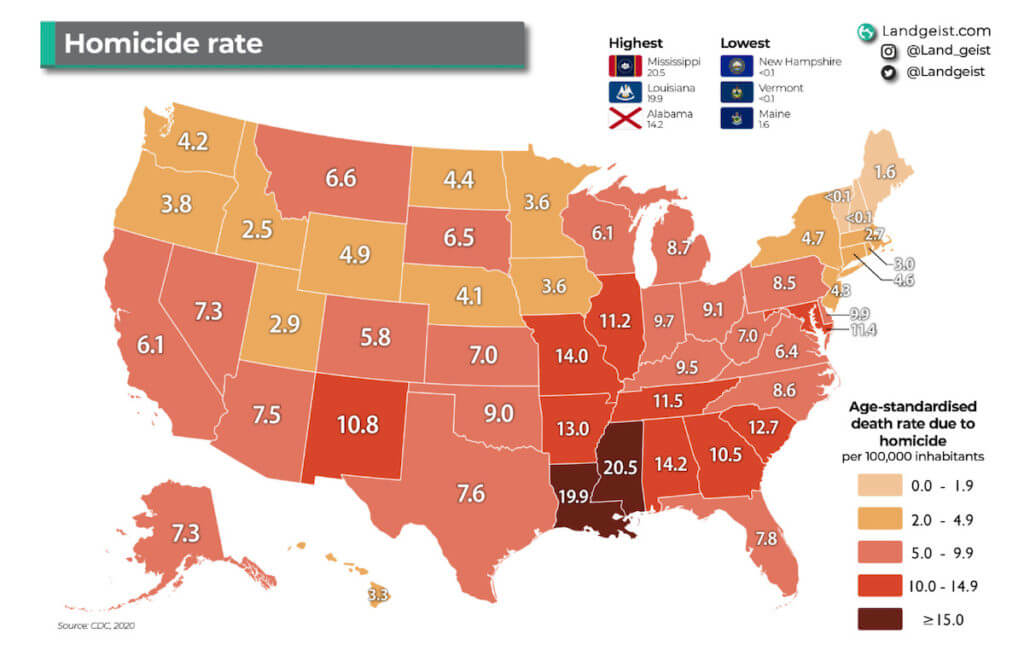An argument that has been making the rounds lately among antigun politicians and gun control activists is that red states have higher murder rates than blue states in large part due to the former’s lack of gun control laws. As evidence, they point to an analysis published on Third Way’s website which concluded that between 2000 and 2020, “the per capita Red State murder rate was 23% higher than the Blue State murder rate when all 21 years were combined.” This was building on a prior article that was limited to looking at 2020 in particular, which found that “the 8.20 murders per 100,000 residents rate in Trump states was 40% higher than the 5.78 murders per 100,000 residents in Biden states.” Their math is not questionable. The authors have done a good job of showing their work, and they have proven the claim they made, which is that Trump-voting states average higher murder rates than Biden-voting states.
The problem with claiming Third Way’s simplistic analysis signals the need for more gun control isn’t with its math but with its parameters. When it comes to the efficacy of gun control, it just isn’t all that useful to limit the categories to the binary of “red states” and “blue states.” To be sure, it is true that, generally speaking, blue states have more gun control and red states have less. But there are so many exceptions to this generality that make the Third Way analysis pointless, at least insofar as its conclusions are used by others to argue for more gun control laws.[1]
SEE ALSO: Firearm Industry Economic Impact Rises 322% Since 2008
To illustrate this point, here is the chart showing the murder rate in each state in 2020, categorized into blue and red states based on whether they voted for Joe Biden or Donald Trump:

Let’s take a look at some of these blue states in terms of how much gun control they actually have in place, especially the three states with some of the lowest murder rates in the nation, New Hampshire, Maine, and Vermont.
New Hampshire gets an “F” from the gun control group Giffords, because it does not have universal background checks, does not require any permit to carry, has no “assault weapon” restrictions or magazine capacity limits, and so on. The state voted for Joe Biden, but when it comes to gun laws, it is less strict than even some Trump-voting states. The same is true for Maine, another which gets an “F” from Giffords. Vermont, the original constitutional carry state, does mildly better because it has universal background checks and a magazine capacity law that was enacted in 2018 as a feel-good measure (the state had no serious crime problem). Still, it only gets a “C-“ from Giffords because it lacks licensing laws, “assault weapon” restrictions, a carry permit requirement, and so on.
SEE ALSO: Henry’s All-New Big Boy Revolvers! — NRA 2023
While those are the most extreme examples, others exist too. Oregon has recently boosted its Giffords grade because it voted to enact gun licensing and magazine capacity limits (those efforts are stalled due to litigation), but as of 2020, it got only a “C+” from Giffords. Minnesota also gets a “C+” because it doesn’t have universal background checks, magazine capacity limits, and more. Other examples can be raised, but the point should be clear by now; there are many Biden-voting states that are either extremely friendly to gun rights or at least much more friendly than the flagship blue states like California and New York.[2] Essentially, the antigun side is using the very low murder rates in some pro-gun states to show that Democrat-favored policies on guns (i.e. gun control) work to lower murder rates. It’s extremely misleading. Using the 2020 election results as the way to categorize states may be valid in some contexts, but there are too many exceptions for it to be useful in a discussion of gun law efficacy.
Of course, this isn’t the only way the data is misleading, even when limited to red states. It is widely known that to the extent there is a “red state murder problem,” it is mostly the cities causing this problem. Missouri makes for an excellent case study on this phenomenon. According to the CDC, in 2021 Missouri had a total of 716 homicides, or a rate of 11.6 per 100,000. That figure is significantly higher than the national average in 2021, which the CDC data tells us was 7.8 per 100,000.
SEE ALSO: Concealed Carrier Shoots Attacker In Cemetery
But where were those homicides in Missouri? For the most part, they were in just three counties out of dozens. Specifically, Jackson County (containing Kansas City), St. Louis County, and St. Louis City. These three areas covering two major cities combine for a total population of 2,007,359, while their homicides added up to 523 in 2021. This means that while these counties account for just 32.5% of Missouri’s population, they are responsible for about 73% of the state’s homicides. In other words, if you are one of the approximately two-thirds of Missourians who don’t live in Jackson County, St. Louis County, or St. Louis City, your homicide rate isn’t really 11.6 per 100,000. It instead drops to roughly 4.6 per 100,000 when those counties are excluded, well below the US national average.

To the extent party affiliations are meaningful, Kansas City’s last Republican mayor left office in 1991. St. Louis’s last Republican Mayor left office in 1949. In Missouri, the two big blue cities drive up homicide rates, not the rest of the state, which leans much more conservative.
SEE ALSO: IWI’s Carmel Rifle — NRA 2023
Finally, the “red state murder problem” moniker is misleading because of the giant variance even just among red states themselves. There isn’t really a red state murder problem, but a southern state murder problem. Look again at Third Way’s chart posted above. Every red state listed with a murder rate higher than 10 per 100,000 is a Southern state (though Missouri and Kentucky both straddle the line between the South and Midwest). There are several red states on the list with low murder rates, such as Idaho, Utah, Iowa, and more. They just aren’t in the South, as this 2020 map demonstrates:

Source – https://landgeist.com/2022/08/13/homicide-rate-in-the-us/
We aren’t going to resolve our problems with violent crime by lazily pointing to states based on their 2020 votes and declaring them “good” and “bad.” A complex problem requires a complex analysis, and not just the two simplistic categories that go into the “red state murder problem.”
***
[1] The article’s authors don’t definitively say why it is that red states have a higher murder rate, but they offer several reasons why they suspect that to be the case. These include guns, poverty, educational attainment, and social services. On guns, they write that “Gun ownership rates are far higher in red states than blue states. Studies have estimated that gun ownership rates are as much as twice as high in a typical red state than a typical blue state. Since 79% of all homicides are committed with a firearm, it stands to reason that more guns will produce more murders, not less.”
[2] It doesn’t really go both ways. Not one Trump-voting state gets higher than a “C-” from Giffords.
*** Buy and Sell on GunsAmerica! All Local Sales are FREE! ***